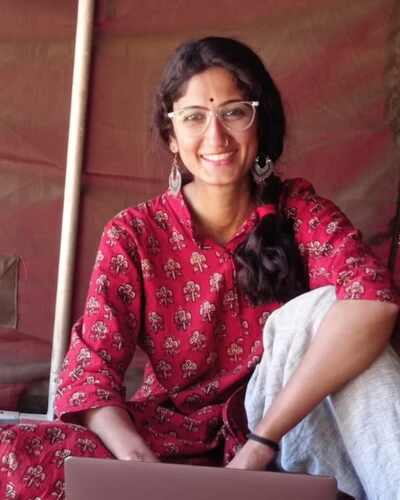Monitoring and evaluation, or M&E, is a commonly used term in the social sector. For an organisation to have an accountable programme design, strengthening its M&E capacity is integral. How does an organisation continue to measure and evaluate its work while attempting to scale? What challenges does a nonprofit, especially one that started working at the grassroots, face in building a sustainable M&E framework? What sort of capacity building needs to take place and how does one gather the resources required? To answer some of these questions, this case study looks at Tapasya—a grassroots nonprofit that has implemented effective M&E as part of its model.
Tapasya was started in 2018 by Tapas Sutradhar and Mrinal Rao to support families from socio-economically vulnerable backgrounds in accessing government social welfare schemes. At its inception, the organisation began as a policy implementation agency. It had a small team of two founders, one project coordinator, and three helpline callers, along with a limited budget of INR 15 lakh per year for the first two years.
Since then, the organisation has burgeoned to a team of 30 and its budget has grown more than sixfold, totalling INR 1 crore as of FY 2023–24. One of the core reasons behind Tapasya’s growth was that the founders were motivated to put in place a strong M&E system right from the organisation’s inception. Having worked in the social sector prior to establishing their own nonprofit, they realised that an effective M&E system was necessary for two main reasons: assessing impact effectively and enabling the professional growth of the organisation’s employees. According to Mrinal and Tapas, “Even though we lacked the resources to build a strong system in Tapasya’s initial phase, the need for and importance of developing our M&E strategy was always clear in our minds.” This clarity pushed them to adopt key processes and systems that gave them leeway to expand their scope.
The importance of intermediaries
Since the co-founders realised that they had a lot to learn, they approached incubators at various stages in order to build key capacities and forge networks. Tapasya was soon successively incubated by Atma, UnLtd India, and the The/Nudge Institute, which accelerated its organisational development.
Mrinal and Tapas emphasised the impact of the knowledge and support that these incubators offered. “Atma hand-held us through the nascent stages and helped build key areas of the organisation as well as our theory of change. Eventually, we became confident enough to make growth decisions independently. UnLtd India (UnLtd) supported us in identifying our niche and helped us deepen and validate our programme design and M&E, and The/Nudge Institute helped us look at the problem and solution differently. We discovered how a programme addressing a local problem can be scaled through various strategies to address a national issue.”
When the organisation was being incubated by UnLtd, it received mentorship in developing M&E strategies to measure both qualitative and quantitative impact. While Tapasya had previously focused heavily on data-driven measurements, UnLtd emphasised the importance of understanding the broader impact on the lives of the families that it works with. This insight highlighted the importance of empowering families and building community resilience by fostering behavioural change. It also resulted in the organisation monitoring and evaluating its interventions more comprehensively.
Growing organisations need strong M&E
The scale of the organisation’s impact has grown significantly over the years as it gradually built capacity on various fronts. For instance, during its first three years, Tapasya focused solely on enabling access to the benefits of Section 12(1)(c) of the Right to Education Act, supporting 22,000 children over this period. Subsequently, it progressed to enabling access to the Pradhan Mantri Matru Vandana Yojana—a maternity benefit scheme for women—and supported 6,000 women as part of this initiative. The leadership realised that many schemes were underutilised, prompting them to shift their model towards implementing multiple schemes across low-income communities in areas ranging from urban slums to remote Adivasi villages. To expand effectively, however, they needed to have a well-oiled M&E system.
The M&E framework enables the nonprofit to set targets for field workers.
Tapasya made sure its work was highly measurable. In order to do this, there were several stages involved: first, identifying families in need, then onboarding them into the system, followed by determining their eligibility criteria and verifying their documents. Next, the organisation tracks the number of applications it has completed and which schemes the households have successfully accessed.
An added benefit is that the M&E framework enables the nonprofit to set targets for field workers. Mrinal elaborated on why they set higher targets than required from the beginning. She states, “In cases where families migrate or withdraw from the process, we may not be able to assist them throughout the entire procedure of receiving their social entitlements. Therefore, we always set higher targets to ensure that we have sufficient margins to be able to help the expected number of families. For example, if we wish to support 300 families, we reach out to 500 eligible families.” This approach ensures that M&E efforts align with the organisation’s overall strategy, allowing for effective tracking and evaluation of their impact.
Adopting a tech-driven M&E strategy
Tapasya’s programmes and outcomes have been measured by recording data through tech-driven strategies—each individual’s data plays a crucial role in monitoring the progress and delivery of welfare schemes. Technology serves as a cornerstone in this process, facilitating the mapping of individuals with eligible schemes and monitoring their progress until they benefit from them. Also, the daily work of each field worker can be tracked, building more accountability, and thereby enhancing the efficiency and credibility of the work.
The adoption of technology has made data collection much less complicated.
But it wasn’t always smooth sailing. There was a time when Tapasya’s impact was faltering as it struggled to implement a robust M&E system. The organisation was unable to accurately track the work done by team members. The community mobilisers used to visit families in the community, but there wasn’t an effective way of tracking information such as how much time they spent in each household, or how many visits they needed before a family received their entitlements. Even the leadership team were not able to prioritise the stage-wise progress of the work that they had to do.
In Tapas’ view, the adoption of technology has made data collection much less complicated. “Imagine if one field worker is working with 300–500 families—it is not possible to remember all the families’ information. A family ID number is generated every time a new family is entered into our database. The next time, they [the field worker] just have to type in the ID number, and all the previously entered data about the family will pop up.” Through the family ID database, the organisation is able to log visits to each household and thereby track the aforementioned parameters that had previously remained unmonitored.
The automation of most of its data collection tools made Tapasya’s tracking system watertight. Witnessing a larger number of families receive their entitlements year on year (via the data they collected) helped generate greater accountability and better performance, as the team members felt a greater sense of ownership over their work.

Both tangible and intangible impact
All partners seek concrete evidence of impact, whether through quantitative data, case studies, or success stories. With relevant data readily available for all projects, the organisation’s partners were able to view the real-time progress of its programmes, which was vital to ensuring trust and transparency. Systematic data collection enables the nonprofit to conduct research studies, validating its work and informing stakeholders within the ecosystem. This data can be shared with government departments to inform intervention strategies, caters to emerging partner needs, and can be used to design projects that directly support communities on the ground.
Tapas indicated that sometimes impact may take forms that cannot necessarily be quantified. Such forms of impact cannot be accounted for as easily as data-driven measures in an M&E framework but are just as meaningful for evaluating impact.
For Tapasya, one such outcome has been the changes in the lives of the sakhis (field workers). These women belong to the communities that they work in and were previously not engaged in any formal employment due to family responsibilities or a lack of opportunities. Once they were provided with the opportunity to work within their community and trained, they witnessed a remarkable transformation. The sakhis reported feeling more aware and informed, noting that they feel valued by their community as integral resources. Even after the organisation moved on to working in other geographies, sakhis have continued to serve as agents of change within their communities. Therefore, the organisation’s impact has stretched beyond just the families captured in their database.
Drawing on their sectoral experience and learnings over their six-year journey at Tapasya, Tapas and Mrinal offered the following advice for other grassroots nonprofits and funders.
Advice for nonprofits
1. Engage in continuous experimentation
According to Mrinal, it’s vital to engage in ongoing experimentation and embrace failure as a means of gaining insights. This allows for informed decisions regarding which strategies to retain and which to discard. At Tapasya, through comprehensive M&E processes and programme design, a wealth of data points has been collected to inform decision-making. This has helped external stakeholders gain confidence in the organisation, as evidenced by its being incubated for six successive years and a sevenfold increase in funding since inception.
2. Never stop learning
The process of learning never stops because the challenges faced by an organisation change as it grows. Stagnation in knowledge indicates a halt in progress.
For instance, when Tapasya conducted a survey of the penetration of 12 welfare schemes in Janta Vasahat, Maharashtra’s second biggest slum, they discovered that the locals were largely only accessing rations under the Public Distribution System, and approximately 80 percent of these schemes were not being availed of by eligible families. They realised that the poor coverage of welfare schemes resulted from a variety of factors, including the government system being overburdened, the lack of support systems, and challenges with service delivery. When Tapasya extended their work to other communities, it found similar patterns, validating the need for the organisation’s interventions.
As the organisation expands, both M&E practices and programme designs must adapt accordingly. Mrinal states, “When Tapasya grew from implementing one scheme to multiple schemes, our entire strategy and M&E had to change with this decision. The funnel to work around one scheme versus multiple schemes is completely different. When working towards implementing a single scheme, the eligibility criteria, necessary documents, and application process were straightforward. However, when you start working on multiple schemes, the complexities increase.”
3. Stand by your ethos
Amid suggestions to transition to a for-profit model, the idea of monetising services arose, especially during the COVID-19 pandemic when funding was scarce. Tapasya conducted a small-scale experiment with 100 families, offering a subscription-based service at a nominal fee of INR 100. Within three months, it became clear that while half of the families were willing to pay and appreciated the service, the other half faced financial constraints and hesitated to enrol. The organisation introspected its core purpose, and it became evident to the team that prioritising profit over their mission of empowering communities would undermine the organisation’s fundamental principles.
Advice to funders
1. Build in the freedom to experiment
Mrinal highlights that funders must recognise the potential for impact when nonprofit partners are granted the freedom to experiment and evolve. In her opinion, “Donors should not fear failure and should support new ideas or issues emerging in the new [nonprofit] ecosystem. For example, our financial partner Indus Action gave us this freedom right from when they started funding us. They have always encouraged us to experiment, be it around working to implement new schemes, redesigning the project, making M&E changes, building tech, or other aspects of the programme. When your partners trust you, you don’t fear failure.”
2. Engage closely and equitably with nonprofit personnel
Donors should deepen their engagement with their partner nonprofits to better understand one another and build a co-learning system for all. This fosters a collaborative learning environment, benefiting everyone involved. Given the positive influence of the sustained and meaningful engagement with funding partners such as Azim Premji Foundation and SVP India, Tapas believes that, “When the donor does not limit themselves to only seeing through the utilisation of the funds but instead engages with the nonprofits in designing the processes and programmes, it always turns out to be valuable.”
According to Tapas and Mrinal, nonprofits also benefit greatly when funders view them as equal partners. They emphasise that engaging as equal partners contributes to the emergence of better ideas, support, and collaboration, and creates a healthy relationship between funders and their nonprofit partners. This approach enables organisations to grow while expanding funders’ portfolios, thereby enhancing the understanding of how to secure and utilise funds effectively.
Blended models are the future
Tapasya’s M&E is among the key anchors that facilitated its growth. And as a result of this growth, Tapasya has already supported 35,000 eligible families in accessing the benefits of various social welfare schemes. They aspire to support 1 million eligible families across India to access government benefits by 2030.
Tapas spoke with confidence about the organisation’s sustainability. He says, “We have a blended model where we work simultaneously with both the government and the community. When the government is supportive, particularly in specific departments and schemes, we can assist a vast number of households. Apart from government collaboration, we also directly engage with communities to provide support, albeit to a lesser extent. However, our operations never halt. These adjustments have evolved over time and are now part of our strategy. Our team continually learns, unlearns, and relearns, maintaining an ongoing cycle. We’re still evolving, and future discussions will likely bring further changes based on our experiences.” By centering M&E throughout its programme design, providing the flexibility to experiment, fail, and innovate, Tapasya is in a strong position to scale and create further impact at the grassroots and national level.
—
About Tapas and Mrinal
Tapas Sutradhar, co-founder and CEO of Tapasya, has 13 years of work experience in the development sector. He manages partnerships, compliance, and technology at Tapasya. Tapas has a master’s degree in social work.
Mrinal Rao, co-founder and COO of Tapasya, has 13 years of work experience in the development sector. She oversees operations, people management, and research at Tapasya. Mrinal has a master’s degree in social work.
—
Know more
- Read this article to to learn whether M&E should be entrusted to an external or internal team.
- Read this article to learn how to build expertise in the M&E field.






